I have an existing structure I'm analyzing and I'm just not matching something. It's a parking deck, live load = 40 psf. Beam is 20" wide x 26" deep, pan joist system is 6" side x 18" deep with 4" slab (6" x 14" + 4" slab). The Beam span is 57' and the tributary width is 28'. The effective prestress force is 350 kips. At the center of the beam positive auxiliary rebar consists of 2#5 and 2#6 bars. At the support negative auxiliary rebar consists of 3#7 and 2#8 bars. I'm getting a capacity of 712 k-ft positive and 872 k-ft negative. I am getting a DEMAND of 630 k-ft positive and 1262 k-ft negative. This can't be right. I'm just checking the existing loads, I haven't put the proposed loads or anything on there. d=23.75". I'm not sure what I'm missing, I may be burnt out and missing something to simple that I may be booted from the forum but any help would be greatly appreciated.
Navigation
Install the app
How to install the app on iOS
Follow along with the video below to see how to install our site as a web app on your home screen.
Note: This feature may not be available in some browsers.
More options
Style variation
-
Congratulations MintJulep on being selected by the Eng-Tips community for having the most helpful posts in the forums last week. Way to Go!
You are using an out of date browser. It may not display this or other websites correctly.
You should upgrade or use an alternative browser.
You should upgrade or use an alternative browser.
Existing Post tension beam doesn't meet what the existing loads would require 4
- Thread starter jplay2519
- Start date
- Status
- Not open for further replies.
hokie66 said:Whether it is draped or not does not affect the ultimate flexural strength.
Whether or not it is draped affects the ultimate external load carrying capacity. Surely, you're not disputing that?
When I think of unbonded PT, the sketch below pops into my head verbatim.
M_external_load - M_balancing < M_ultimate
OR
M_external_load < M_ultimate + M_balancing
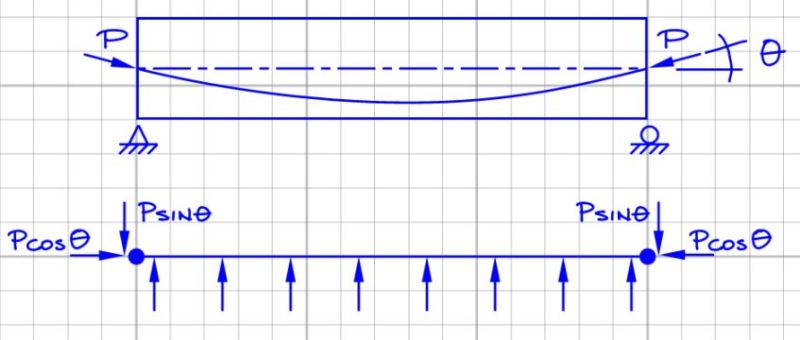
I like to debate structural engineering theory -- a lot. If I challenge you on something, know that I'm doing so because I respect your opinion enough to either change it or adopt it.
Kootk,
Wrong.
The uplift effect of the tendons is NOT included in the ultimate strength checks, nor is it included in the crack section checks. Only the Secondary (parasitic) prestress is included at ultimate as others have suggested. And this does not only happen in the Southern Hemisphere, it happens in the Northern Hemisphere as well.
It is only included in uncracked section checks because people think of it as a total prestress moment. It can be separated there as well. Two versions shown below.
The full prestress effect is P.e + Msec = Mp at any point.
When you are doing uncracked section checks
stress = P/A + M/Z where
M = Mdl + Mll + Mp = Mdl + Mll + P.e + Msec
You could also write this as
stress - P.e/z = P/A + M/Z where
M = Mdl + Mll + Mp = Mdl + Mll + Msec
Where P.e is your load balancing effect.
The second version is consistent with how it is done for crack section checks and ultimate strength calculations where the P.e effect is regarded as part of the capacity and NOT part of the applied loading.
If you look at cracked section checks under any condition from transfer to ultimate strength, P.e is actually part of your resisting capacity. If you also include it as part of the applied loading, you are counting it twice.
PS If you want a good book on PT I would be looking at Collins and Mitchell or RI Gilbert books, or go back to the earlier writers, Leonhardt or Guyon. Apparently the book mentioned above does not even recognise that deflections need to be calculated (2nd hand as I have not read it myself)!
Wrong.
The uplift effect of the tendons is NOT included in the ultimate strength checks, nor is it included in the crack section checks. Only the Secondary (parasitic) prestress is included at ultimate as others have suggested. And this does not only happen in the Southern Hemisphere, it happens in the Northern Hemisphere as well.
It is only included in uncracked section checks because people think of it as a total prestress moment. It can be separated there as well. Two versions shown below.
The full prestress effect is P.e + Msec = Mp at any point.
When you are doing uncracked section checks
stress = P/A + M/Z where
M = Mdl + Mll + Mp = Mdl + Mll + P.e + Msec
You could also write this as
stress - P.e/z = P/A + M/Z where
M = Mdl + Mll + Mp = Mdl + Mll + Msec
Where P.e is your load balancing effect.
The second version is consistent with how it is done for crack section checks and ultimate strength calculations where the P.e effect is regarded as part of the capacity and NOT part of the applied loading.
If you look at cracked section checks under any condition from transfer to ultimate strength, P.e is actually part of your resisting capacity. If you also include it as part of the applied loading, you are counting it twice.
PS If you want a good book on PT I would be looking at Collins and Mitchell or RI Gilbert books, or go back to the earlier writers, Leonhardt or Guyon. Apparently the book mentioned above does not even recognise that deflections need to be calculated (2nd hand as I have not read it myself)!
rapt said:Where P.e is your load balancing effect.
P.e is not the load balancing effect. The load balancing effect is a result of the angular change in tendon profile (Your Msec?)
rapt said:If you look at cracked section checks under any condition from transfer to ultimate strength, P.e is actually part of your resisting capacity. If you also include it as part of the applied loading, you are counting it twice.
AND
rapt said:The second version is consistent with how it is done for crack section checks and ultimate strength calculations where the P.e effect is regarded as part of the capacity and NOT part of the applied loading.
I'm not treating P.e a part of the applied load rapt. I'm treating the effect of tendon angular change as part of the applied load as discussed in that PTI document that we've been passing around and as illustrated in the sketch that I posted with my last comment.
rapt said:The uplift effect of the tendons is NOT included in the ultimate strength checks, nor is it included in the crack section checks...
Checks, checks, checks... The simple fact of the matter is that tendon drape helps to resist load. Whether that assistance is conceptualized as an external action reducing demand, or as an internal action increasing capacity, is simply a matter of choice and convenience. Since most designers are interested in the ability to carry load external to the concrete, I find it convenient to take the view that tendon drape increases capacity.
Here's a question for you: if tendon drape does not improve a pre-stressed member's ability to resist load, then why do we bother with it?
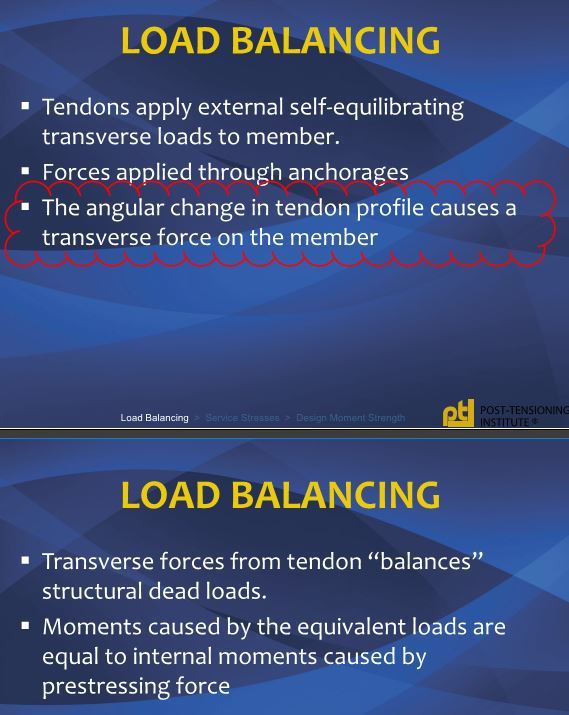
I like to debate structural engineering theory -- a lot. If I challenge you on something, know that I'm doing so because I respect your opinion enough to either change it or adopt it.
hokie said:A prestressing strand in a pretensioned member, with the strand flat, provides the same ultimate capacity as a draped strand of the same size and with the same effective depth.
The draped strand member would have greater load resisting capacity than the straight strand member in real terms. We simply choose to ignore that improvement in our ultimate strength checks. Some examples where we do include tendon drape in ultimate strength checks would include:
1) Suspension bridges
2) Wood/concrete beams reinforced with external PT.
Conceptually, these are the same.
I like to debate structural engineering theory -- a lot. If I challenge you on something, know that I'm doing so because I respect your opinion enough to either change it or adopt it.
KootK said:@Hokie/IDS: Your statements imply that there was something inaccurate or misleading in mine. And I dispute that. I believe that you're simply viewing things from what I have come to see as the "Aussie perspective" on PT design. And that is likely influenced by the prevalent use of bonded PT in your area.
Just for the record, I hope I can sometimes be ingenious, but I am not Ingenuity.
Doug Jenkins
Interactive Design Services
The reason draped strand structures have greater capacity is because they are continuous. That is one answer to your question about why we do it. The other answer is that it helps with controlling deflection by creating a preselected shape of the top surface.
So, I take it that you have accepted that ultimate strength computations are not affected by drape, at least in the context of prestressed concrete?
So, I take it that you have accepted that ultimate strength computations are not affected by drape, at least in the context of prestressed concrete?
Feeling picked on Doug! I thought you would have had more to add!
Kootk,
It has nothing to do with bonded/unbonded prestress. The only difference with unbonded is that there is no strain/compatibility between the prestressing steel and the concrete surrounding it, so everyone tries to guess the stress in the unbonded steel at ultimate as it is not directly related to the strain in the concrete.
To look at the simplest case of a simply supported span (just to take continuity effects out of it), to balance a load of w, the moment at mid span from the load balancing would be
mp = wl^2 / 8
The prestress force to balance this is mp / e = P
so P = wl^2 / 8 e
or P e = wl^2/8
So the moment effect of load balancing = P.e
This is true at any point in ant determinate member. In indeterminate members, secondary moment effects change this but the overall logic is still the same. In indeterminate members, the secondary moment effect is considered to be an external action, while the P e (balancing effect) is considered to be part of the capacity.
I sincerely hope you have not designed any PT members by this methodology as they will be under capacity by P e, so could be reaching their true ultimate capacity at or below the service moment.
Kootk,
It has nothing to do with bonded/unbonded prestress. The only difference with unbonded is that there is no strain/compatibility between the prestressing steel and the concrete surrounding it, so everyone tries to guess the stress in the unbonded steel at ultimate as it is not directly related to the strain in the concrete.
To look at the simplest case of a simply supported span (just to take continuity effects out of it), to balance a load of w, the moment at mid span from the load balancing would be
mp = wl^2 / 8
The prestress force to balance this is mp / e = P
so P = wl^2 / 8 e
or P e = wl^2/8
So the moment effect of load balancing = P.e
This is true at any point in ant determinate member. In indeterminate members, secondary moment effects change this but the overall logic is still the same. In indeterminate members, the secondary moment effect is considered to be an external action, while the P e (balancing effect) is considered to be part of the capacity.
I sincerely hope you have not designed any PT members by this methodology as they will be under capacity by P e, so could be reaching their true ultimate capacity at or below the service moment.
First a comment on Load balancing
If you look at the Leonhardt (No he was not Australian) bible on PT, written well before TY Lin discussed load balancing, he was talking about Equivalent Moments from prestress and relating them to the Moment diagram in a span. He was basically talking about Moment Balancing, later popularized by Lin into Load Balancing. Problem with Load Balancing is that the logic only works easily in simple cases and where there is no change in the prestress force in a span. Moment Balancing is much easier to work with and it is related to P.e at every point in the span. For a parabolic tendon that comes out to a balanced load over the length of the parabola. Whew you start adding reverse curves in your tendons, straight lengths, harped profiles and transmission lengths in pre-tensioned strands and post tensioned dead ends, then load balancing is near impossible to work with.
To answer you last question
"if tendon drape does not improve a pre-stressed member's ability to resist load, then why do we bother with it?"
For several reasons,
Continuous members would require double prestress, straight top and bottom without it, so would have twice as much prestress. And most buildings have continuous members!
It is convenient for calculation, especially in the old days when we hade to do moment distribution by hand to get the moments and shears!
It provides a prestress resisting effect that is simple for quick comparisons with UDL loading.
It raises the anchorages from the bottom at the ends to give cover to the anchorage and to provide sufficient concrete to resist bursting stresses.
It reduces the likelihood of transfer stress problems at anchorages where there is no SW moment to act against the prestress moments induced there by straight tendons in the bottom, as is often experienced in pre-tensioned members and results in some strands with unbonded lengths and sometimes compression face strands.
When Lin first suggest the Load Balancing logic, people liked the idea of being able to get a "flat" floor. Unfortunately, it was only flat under one load case at one instance in time, so was really useless, but the logic was used for a long time.
Interestingly, you can reduce your deflections in a simply supported span by using a straight tendon in the bottom if you could anchor it and put up with any transfer stress problems caused by it. And the same in a cantilever with a straight tendon in the top, again if you can anchor it
If you look at the Leonhardt (No he was not Australian) bible on PT, written well before TY Lin discussed load balancing, he was talking about Equivalent Moments from prestress and relating them to the Moment diagram in a span. He was basically talking about Moment Balancing, later popularized by Lin into Load Balancing. Problem with Load Balancing is that the logic only works easily in simple cases and where there is no change in the prestress force in a span. Moment Balancing is much easier to work with and it is related to P.e at every point in the span. For a parabolic tendon that comes out to a balanced load over the length of the parabola. Whew you start adding reverse curves in your tendons, straight lengths, harped profiles and transmission lengths in pre-tensioned strands and post tensioned dead ends, then load balancing is near impossible to work with.
To answer you last question
"if tendon drape does not improve a pre-stressed member's ability to resist load, then why do we bother with it?"
For several reasons,
Continuous members would require double prestress, straight top and bottom without it, so would have twice as much prestress. And most buildings have continuous members!
It is convenient for calculation, especially in the old days when we hade to do moment distribution by hand to get the moments and shears!
It provides a prestress resisting effect that is simple for quick comparisons with UDL loading.
It raises the anchorages from the bottom at the ends to give cover to the anchorage and to provide sufficient concrete to resist bursting stresses.
It reduces the likelihood of transfer stress problems at anchorages where there is no SW moment to act against the prestress moments induced there by straight tendons in the bottom, as is often experienced in pre-tensioned members and results in some strands with unbonded lengths and sometimes compression face strands.
When Lin first suggest the Load Balancing logic, people liked the idea of being able to get a "flat" floor. Unfortunately, it was only flat under one load case at one instance in time, so was really useless, but the logic was used for a long time.
Interestingly, you can reduce your deflections in a simply supported span by using a straight tendon in the bottom if you could anchor it and put up with any transfer stress problems caused by it. And the same in a cantilever with a straight tendon in the top, again if you can anchor it
Hi rapt - just busy doing other stuff today 
I might look in this evening and see if I have anything to add.
Doug Jenkins
Interactive Design Services
I might look in this evening and see if I have anything to add.
Doug Jenkins
Interactive Design Services
-
1
- #32
mike20793 said:I highly recommend the book "Post-Tensioned Concrete: Principles and Practice" by Dirk Bondy and Bryan Allred. Dirk's father, Ken, is one of the pioneers of PT design in North America and this is an incredible PT resource from basic concepts all the way to common field errors and practical detailing for constructability. You will be hard pressed to find a better reference for PT design. The chapter on flexure is very straight forward and does an excellent job explaining ultimate strength of indeterminate systems. I can probably scan a few pages and include them later if you're still having trouble, jplay.
If anyone ever gets a chance to view his PT class from UCLA, you will not be disappointed. His commentary on the confusing shear provisions in the code and secondary effects in indeterminate systems alone makes it worthwhile. His father, Ken, is a "Teacher's Assistant" so you get good info from people that have been doing it for over 60 years combined.
A few of my comments on the book:
1. Very USA-centric re design and practices.
2. No mention of deflections. Not one word. All member sizes in the examples are selected from L/D ratios and no follow up check on long-term deflections, nor any mention about cantilever deflections.
3. Whilst there are many example calculations, there is too much reference, in my opinion, to PT Data, the authors software for designing PT floor systems.
4. Interesting that there are photos in the book of UCLA students doing line dancing! That is a first. I guess if TY Lin can author a Shakespeare parody in his 1963 book, a photo of line dancing is "acceptable" too.
5. The book is expensive - like US$150 for a paperback. But, full disclosure, I am a tight-arse and buy lots of $4 books at Thriftbooks.com
6. There are a good number of practical worked examples.
7. Great collection of photos from project sites - including the good, bad and the ugly (tendon ruptures, etc).
Time will tell re Ken's comments:
Ken Bondy's review from Amazon.com said:...This book is destined to become the definitive work on the design of post-tensioned concrete buildings for many decades to come. Written by structural engineers who design post-tensioned concrete buildings for a living and teach how to design them at the university level, there has simply never been anything like this book...
jplay2519,
Now that we have all 'hijacked' your thread...here is some on-topic info:
1. With the pan joist spacing of 6' c/c, the prestress is balancing about 70% of DL to interior spans, but less in end spans.
2. Based upon a quick check I ran, you require significant more flexural reinf, as you indicated. Calcs based up 14x0.5" UNbonded strands, or 350 kips.
3. There are ductility problems in negative moments regions adjacent to interior columns, requiring compression reinf.
4. Long-term delfections are up there.
Factored Moment and Shear: (all spans loaded, no LL reduction):
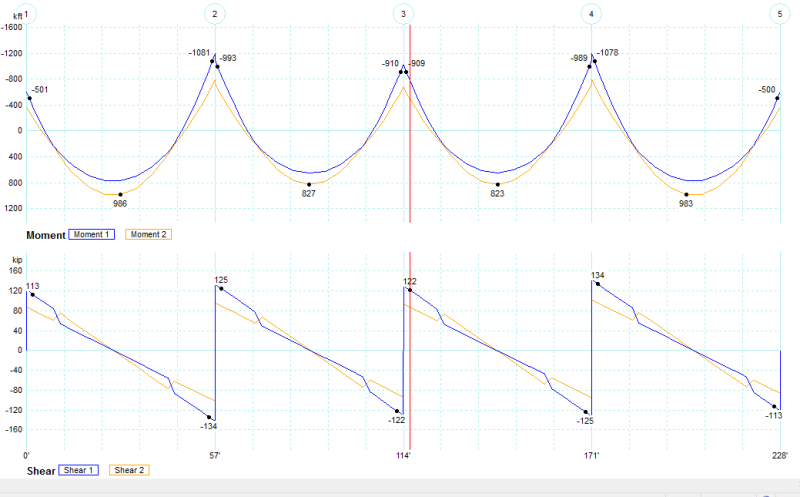
Mild Steel reinf required, for end span:
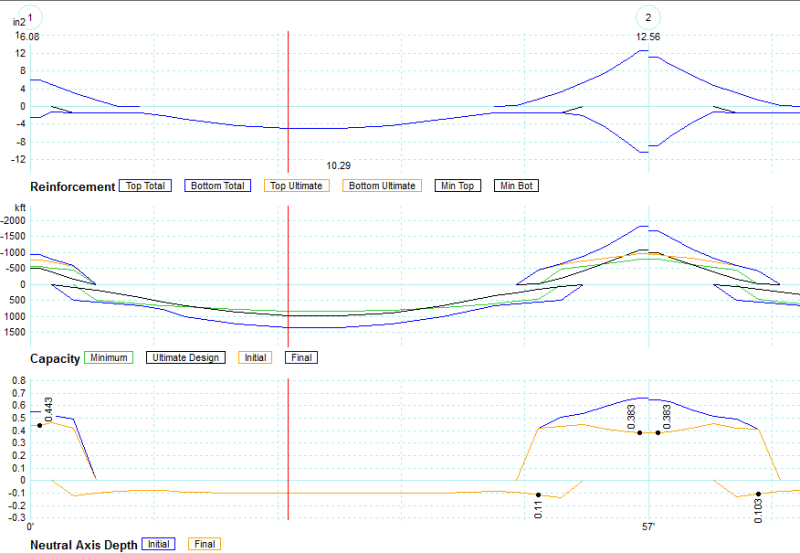
Deflection estimates:
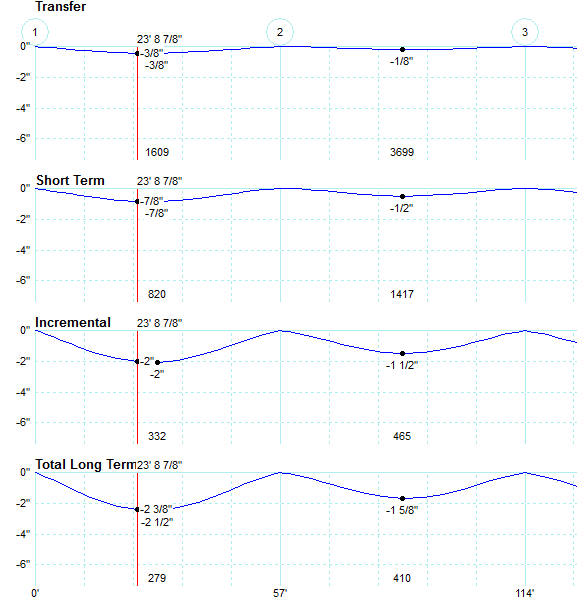
Now that we have all 'hijacked' your thread...here is some on-topic info:
1. With the pan joist spacing of 6' c/c, the prestress is balancing about 70% of DL to interior spans, but less in end spans.
2. Based upon a quick check I ran, you require significant more flexural reinf, as you indicated. Calcs based up 14x0.5" UNbonded strands, or 350 kips.
3. There are ductility problems in negative moments regions adjacent to interior columns, requiring compression reinf.
4. Long-term delfections are up there.
Factored Moment and Shear: (all spans loaded, no LL reduction):

Mild Steel reinf required, for end span:

Deflection estimates:

- Thread starter
- #34
Thanks @Ingenuity. I thought I was going crazy. I don't see how you could so under reinforce this AND get it though permitting. I need to pick up a software package to be able to get into these calcs because the hand calcs are nice but I think clients are going to take issue if they ever get a peer review with Post tension hand checks. Does anybody do demos of their PT software? I only ever see people selling.
Is rapt the raptsoftware guy or is that just a coincidence? I'm glad I'm on this thread. Learning something from the guys I usually just lurk on. Hopefully I can start contributing to the forum soon.
Is rapt the raptsoftware guy or is that just a coincidence? I'm glad I'm on this thread. Learning something from the guys I usually just lurk on. Hopefully I can start contributing to the forum soon.
- Thread starter
- #36
Alright, I've had some time to reflect and I've got a Kindle copy of Gilbert's 2015 textbook in front of me at this very moment. Time to get back in the saddle and take my licks. It's cowardice when the loser of argument assumes that they have the moral prerogative to end it. Some preliminaries:
1) @jplay: I believe myself to have been fundamentally incorrect with regard to the advice that I supplied above. Please disregard all of it save that sexy example problem that I provided. I considered continuing this conversation in a separate thread of my own so as not to hijack but, in the end, I decided to carry on here. The thread seems to have wrapped up and I figured that you would enjoy the ensuing technical debate/discussion/gong show. Let me know if I'm wrong about that.
2) @rapt: I regret and apologize for my outburst the other day. Things around here work best when we check our egos and pride at the door. I slipped up and let my lizard brain run amok.
3) No one needs to fear for any of the post-tensioned slabs and transfer beams that I have designed in the past. All of that work occurred some time ago when I used to actually perform the detailed design of things. Back then, I used the same equations, examples, and software as everyone else and, consequently, came up with similar results. Frankly, I believe that I'm a much better engineer now as I question many fundamental things that I previously took for granted in the interest of productivity. From time to time, as now, that results in my having to admit some errors in my thinking.
4) I own pretty much all of the important books on pre-stressed concrete. And I've flipped through most of them, at least briefly, in the last 96 hours. None of them seems to present the information that I seek in quite the way that I need it presented. No doubt it's out there; I just haven't been able to find it in the time that I have available. Consequently, I'm going to attempt to derive the relevant aspects of PT behavior myself, from first principles. And I hope that folks here will critique the material that I present in order to help me get things sorted. Please be kind. Being wrong is an opportunity without equal but, nonetheless, it's painful.
5) No doubt, the things that I'll be "discovering" will be things that you think are obvious and things you may have already told me above. Don't think that I haven't been listening. I have. Sometimes it just takes sketches and a particular presentation in order for me to undo my own long held engineering dogma.
I like to debate structural engineering theory -- a lot. If I challenge you on something, know that I'm doing so because I respect your opinion enough to either change it or adopt it.
1) @jplay: I believe myself to have been fundamentally incorrect with regard to the advice that I supplied above. Please disregard all of it save that sexy example problem that I provided. I considered continuing this conversation in a separate thread of my own so as not to hijack but, in the end, I decided to carry on here. The thread seems to have wrapped up and I figured that you would enjoy the ensuing technical debate/discussion/gong show. Let me know if I'm wrong about that.
2) @rapt: I regret and apologize for my outburst the other day. Things around here work best when we check our egos and pride at the door. I slipped up and let my lizard brain run amok.
3) No one needs to fear for any of the post-tensioned slabs and transfer beams that I have designed in the past. All of that work occurred some time ago when I used to actually perform the detailed design of things. Back then, I used the same equations, examples, and software as everyone else and, consequently, came up with similar results. Frankly, I believe that I'm a much better engineer now as I question many fundamental things that I previously took for granted in the interest of productivity. From time to time, as now, that results in my having to admit some errors in my thinking.
4) I own pretty much all of the important books on pre-stressed concrete. And I've flipped through most of them, at least briefly, in the last 96 hours. None of them seems to present the information that I seek in quite the way that I need it presented. No doubt it's out there; I just haven't been able to find it in the time that I have available. Consequently, I'm going to attempt to derive the relevant aspects of PT behavior myself, from first principles. And I hope that folks here will critique the material that I present in order to help me get things sorted. Please be kind. Being wrong is an opportunity without equal but, nonetheless, it's painful.
5) No doubt, the things that I'll be "discovering" will be things that you think are obvious and things you may have already told me above. Don't think that I haven't been listening. I have. Sometimes it just takes sketches and a particular presentation in order for me to undo my own long held engineering dogma.
I like to debate structural engineering theory -- a lot. If I challenge you on something, know that I'm doing so because I respect your opinion enough to either change it or adopt it.
Diagrams similar to this pop up frequently in derivations of the ultimate moment capacity of PT beams. That's probably because it's the simplest presentation. The limits of the free body diagram are defined such that they include the concrete and the PT tendon. I agree that it's correct and statically equivalent to other formulations but, unfortunately, I just don't feel it. In particular, for unbonded tendons, it bothers me that the Tps force is shown at a location where it isn't actually acting on the concrete. My rational brain gets it but, again, I just don't feel it. Instead, I'm going to study the concrete and PT tendon separately.
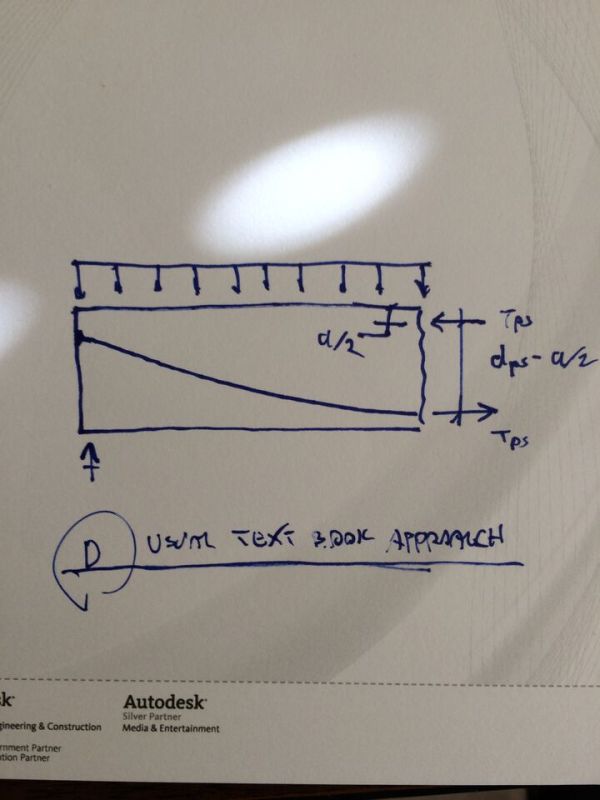
I like to debate structural engineering theory -- a lot. If I challenge you on something, know that I'm doing so because I respect your opinion enough to either change it or adopt it.

I like to debate structural engineering theory -- a lot. If I challenge you on something, know that I'm doing so because I respect your opinion enough to either change it or adopt it.
In detail A below, I've examined the equilibrium of the cable independently of everything else. I've ignored complicating phenomena like friction, wobble, relaxation etc. By definition, moments taken about point O sum to zero. The thing stays put.
In detail B below, I've examined the equilibrium of the concrete without the PT tendon and, importantly, without the compression block reaction at the section cut. Because the forces that the tendon impose on the concrete are the inverse of those imposed by the concrete on the tendon, I again take the moment summation about point O to be zero. I propose this as non-rigorous proof (to myself) that balancing forces and anchorage reactions form a self-equibrilating system that, taken in concert, do nothing to improve bending capacity. I also offer this as one explanation for the following statement made by hokie:
In detail C, I again study the concrete on its own, this time with the compression block reaction included. I come up with the usual ultimate moment capacity formulation. This is the part that I have trouble feeling with the usual presentation (my previous post). Looked at in isolation for an unbonded system, there's no tendon tension force on the concrete at point O.
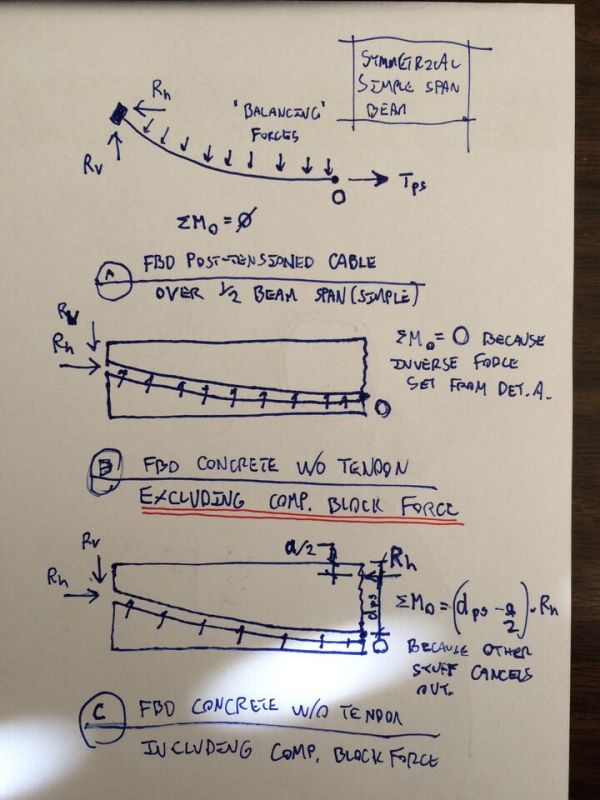
I like to debate structural engineering theory -- a lot. If I challenge you on something, know that I'm doing so because I respect your opinion enough to either change it or adopt it.
In detail B below, I've examined the equilibrium of the concrete without the PT tendon and, importantly, without the compression block reaction at the section cut. Because the forces that the tendon impose on the concrete are the inverse of those imposed by the concrete on the tendon, I again take the moment summation about point O to be zero. I propose this as non-rigorous proof (to myself) that balancing forces and anchorage reactions form a self-equibrilating system that, taken in concert, do nothing to improve bending capacity. I also offer this as one explanation for the following statement made by hokie:
hokie said:A prestressing strand in a pretensioned member, with the strand flat, provides the same ultimate capacity as a draped strand of the same size and with the same effective depth.
In detail C, I again study the concrete on its own, this time with the compression block reaction included. I come up with the usual ultimate moment capacity formulation. This is the part that I have trouble feeling with the usual presentation (my previous post). Looked at in isolation for an unbonded system, there's no tendon tension force on the concrete at point O.

I like to debate structural engineering theory -- a lot. If I challenge you on something, know that I'm doing so because I respect your opinion enough to either change it or adopt it.
- Thread starter
- #40
@kootk I definitely appreciated the debate on the thread. It gives the opportunity to learn. I haven't done much PT design so it helps to have more experienced engineers help understand the design and principles behind the different system types.
- Status
- Not open for further replies.
Similar threads
- Question
- Replies
- 9
- Views
- 9K
- Question
- Replies
- 6
- Views
- 11K
- Question
- Replies
- 1
- Views
- 6K
- Replies
- 12
- Views
- 10K
- Replies
- 3
- Views
- 651
